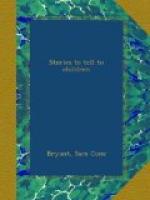Perhaps the common-sense way of setting a standard for one’s own voice is to remember that the purpose of a speaking voice is to communicate with others; their ears and minds are the receivers of our tones. For this purpose, evidently, a voice should be, first of all, easy to hear; next, pleasant to hear; next, susceptible of sufficient variation to express a wide range of meaning; and finally, indicative of personality.
Is it too quixotic to urge teachers who tell stories to little children to bear these thoughts, and better ones of their own, in mind? Not, I think, if it be fully accepted that the story hour, as a play hour, is a time peculiarly open to influences affecting the imitative faculty; that this faculty is especially valuable in forming fine habits of speech; and that an increasingly high and general standard of English speech is one of our greatest needs and our most instant opportunities in the American schools of to-day.
And now we come to the stories!
STORIES TO TELL TO CHILDREN
Two little riddles in rhyme[1]
[1] These riddles were taken from the Gaelic, and are charming examples of the naive beauty of the old Irish, and of Dr. Hyde’s accurate and sympathetic modern rendering. From “Beside the Fire” (David Nutt, London).
There’s a garden that I ken,
Full of little gentlemen;
Little caps of blue they wear,
And green ribbons, very fair.
(Flax.)
From house to house he goes,
A messenger small and slight,
And whether it rains or snows,
He sleeps outside in the night.
(The path.)
THE LITTLE PINK ROSE
Once there was a little pink Rosebud, and she lived down in a little dark house under the ground. One day she was sitting there, all by herself, and it was very still. Suddenly, she heard a little tap, tap, tap, at the door.
“Who is that?” she said.
“It’s the Rain, and I want to come in;” said a soft, sad, little voice.
“No, you can’t come in,” the little Rosebud said.
By and by she heard another little tap, tap, tap on the window pane.
“Who is there?” she said.
The same soft little voice answered,
“It’s the Rain, and I want to come in!”
“No, you can’t come in,” said the little Rosebud.
Then it was very still for a long time. At last, there came a little rustling, whispering sound, all round the window: Rustle, whisper, whisper.
“Who is there?” said the little Rosebud.
“It’s the Sunshine,” said a little, soft, cheery voice, “and I want to come in!”
“N—no,” said the little pink rose, “you can’t come in.” And she sat still again.
Pretty soon she heard the sweet little rustling noise at the key-hole.




